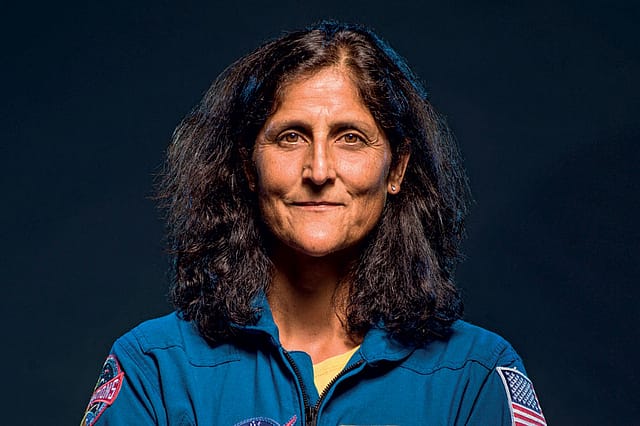Sunita Williams: Space Queen

TO APPRECIATE WHY astronaut Sunita Williams figures in the Indian imagination you have to turn to the state of India's space programme in 2006. At present, we have been on the moon, orbited Mars and sent vessels towards the sun to study it but back then, ISRO was still an overachiever though mainly known for satellites. And then there was Williams, not an Indian, but who became the second woman of Indian origin to go to space as part of a mission by the US space agency NASA. Three years before that, the first Indian-origin woman to go to space, Kalpana Chawla, had died in a tragic accident when the space shuttle Columbia exploded while returning to Earth. When Williams took off in the Discovery, India rejoiced, basking in reflected glory. On Wednesday, June 5, she once again headed back to space on the Starliner, a spacecraft that heralds Boeing's entry into this sector, making it her third time.
Williams is of Indian descent through her father, a doctor from Gujarat who subsequently went to the US and made his name as a neuroanatomist. Her mother is Slovenian. Astronauts typically come into the field sideways, often having previous experience as a pilot. In Williams' case, too, that was the trajectory. She began in the US navy flying helicopters in logistics, rescue and relief operations but her experience broadened until she had flown more than 30 aircraft. She was selected for the NASA astronaut programme, but before that she also did a Master's in Science in Engineering Management. Her training started in August 1998 and it ranged from scientific briefings to survival techniques, like living in an underwater habitat for days on end.
2026 New Year Issue
Essays by Shashi Tharoor, Sumana Roy, Ram Madhav, Swapan Dasgupta, Carlo Pizzati, Manjari Chaturvedi, TCA Raghavan, Vinita Dawra Nangia, Rami Niranjan Desai, Shylashri Shankar, Roderick Matthews, Suvir Saran
It would still take eight years before she could fly on her first mission into space and stay in the International Space Station (ISS). It wasn't a short stint. She was there for over six months, a record for a woman astronaut then. In an interview to the BBC once, she detailed how much mental and physical preparedness that involves, and that it was important to be at "peace with everything" before take-off.She said, "We weren't exactly sure how long it was going to be because I went up and back on the space shuttle which was dependent on weather for launch and landing. So you might have to say goodbye a couple of times and you might get excited to come home and then have to wait. It was an emotional rollercoaster, particularly because it was my first space flight."
Once on the ISS, she had to consciously maintain a routine that prevented psychological collapse. What really helped was the long training time that had been spent together by the members of the team on earth. They knew each other well and could be a foil when it came to work and isolation. Something extraordinary that Williams did in that mission was to be the first astronaut to ever run a marathon in space. She did it on a treadmill in the ISS simultaneously with the Boston Marathon happening on earth, finishing the race in 4 hours and 24 minutes.
She returned to the ISS for a four-month stint in 2012. Her profile in the NASA website says: "With 50 hours and 40 minutes, Williams once again held the record for total cumulative spacewalk time by a female astronaut (has since been overtaken by Peggy Whitson with 10 spacewalks). In addition, Williams, who has spent a total of 322 days in space on two missions, now ranks sixth on the all-time U.S. endurance list, and second all-time for a female astronaut." In her latest mission, Williams is back to the ISS after 12 years but with a difference. The spacecraft Starliner is owned by Boeing and after SpaceX, this will now be the second private company to offer such a service. Space flights are being privatised and Williams at the age of 58 is part of this movement. The mission itself will be of much shorter duration. She will return in a week. In her earlier flights, she had carried a small idol of Ganesha and samosas as a part of her Indian heritage. Once she is back, we might again get confirmation of what aspect of her Indianness went to space with her this time.
